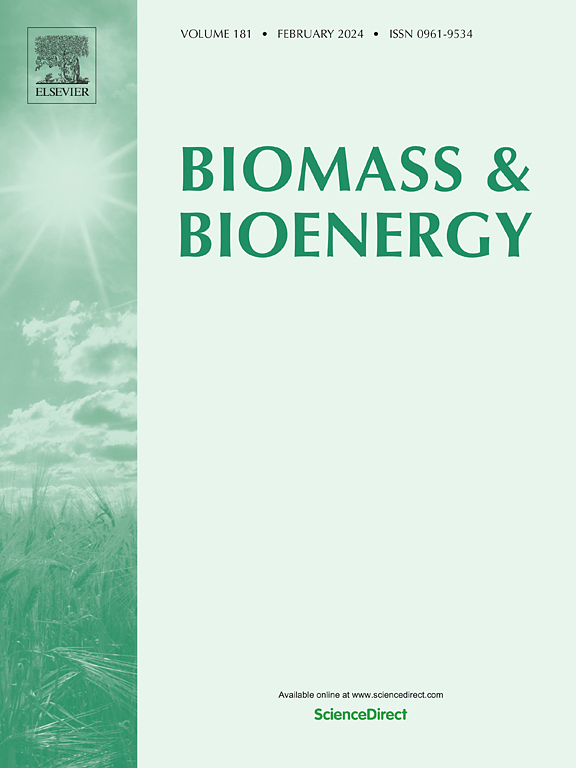钴负载羟基磷灰石中受挫Lewis酸碱对选择性还原生物质衍生糠醛胺化成糠胺
IF 5.8
2区 生物学
Q1 AGRICULTURAL ENGINEERING
引用次数: 0
摘要
通过木质纤维素醛的还原胺化反应合成伯胺是一种具有吸引力的可持续催化途径。本文报道了钴负载羟基磷灰石(Co/HAP)非均相催化剂对糠醛的还原胺化反应,并在温和的反应条件下以99%的选择性完全转化为糠胺。采用XRD、n2 -解吸、NH3/CO2-TPD、XPS、TEM和FT-IR等技术对催化剂的理化性质进行了深入研究,建立了催化剂的构效关系。活性位点的选择性中毒研究表明,Lewis酸性和碱性位点有助于C=N键的激活,并有利于胺化过程中H-H键的异裂裂解。适宜的Co0种类、良好的Co在HAP载体上的分散以及强的金属-载体相互作用导致了高选择性的糠胺(FAM)。在HAP上添加7 wt% Co的催化剂比非贵金属基非均相催化剂表现出优异的活性,与贵金属基催化剂表现出相当的活性。此外,在FAM的克级合成中,催化剂也表现出89%的选择性。该催化剂在连续5次循环运行中保持了可重复使用的活性,损失可以忽略不计。本文章由计算机程序翻译,如有差异,请以英文原文为准。

Frustrated Lewis acid-basic pair in cobalt supported hydroxyapatite for selective reductive amination of biomass-derived furfural to furfurylamine
The synthesis of primary amines via reductive amination of lignocellulose-derived aldehydes is an appealing sustainable catalytic route. Herein, cobalt supported hydroxyapatite (Co/HAP) heterogeneous catalysts reported for reductive amination of furfural and achieved complete conversion with >99 % selectivity to furfurylamine under mild reaction conditions. The physiochemical characteristics of the catalysts were investigated thoroughly using XRD, N2-desorption, NH3/CO2-TPD, XPS, TEM and FT-IR spectroscopic techniques to build their structural-activity relationship. The selective poisoning of active sites studies reveals that Lewis acidic and basic sites aided in the activation of the C=N bond and favored heterolytic cleavage of the H-H bond during amination. The expedient amount of Co0 species, improved dispersion of Co on HAP support, as well as strong metal-support interaction resulted in high furfurylamine (FAM) selectively. The catalyst with 7 wt% Co on HAP exhibited excellent activity over non-noble metal-based heterogeneous catalysts and on par activity with the precious metal-based catalysts. Furthermore, in the gram-scale synthesis of FAM also the catalyst exhibited 89 % selectivity. The catalyst sustained its reusable activity with five consecutive recycle runs with negligible loss.
求助全文
通过发布文献求助,成功后即可免费获取论文全文。
去求助
来源期刊

Biomass & Bioenergy
工程技术-能源与燃料
CiteScore
11.50
自引率
3.30%
发文量
258
审稿时长
60 days
期刊介绍:
Biomass & Bioenergy is an international journal publishing original research papers and short communications, review articles and case studies on biological resources, chemical and biological processes, and biomass products for new renewable sources of energy and materials.
The scope of the journal extends to the environmental, management and economic aspects of biomass and bioenergy.
Key areas covered by the journal:
• Biomass: sources, energy crop production processes, genetic improvements, composition. Please note that research on these biomass subjects must be linked directly to bioenergy generation.
• Biological Residues: residues/rests from agricultural production, forestry and plantations (palm, sugar etc), processing industries, and municipal sources (MSW). Papers on the use of biomass residues through innovative processes/technological novelty and/or consideration of feedstock/system sustainability (or unsustainability) are welcomed. However waste treatment processes and pollution control or mitigation which are only tangentially related to bioenergy are not in the scope of the journal, as they are more suited to publications in the environmental arena. Papers that describe conventional waste streams (ie well described in existing literature) that do not empirically address ''new'' added value from the process are not suitable for submission to the journal.
• Bioenergy Processes: fermentations, thermochemical conversions, liquid and gaseous fuels, and petrochemical substitutes
• Bioenergy Utilization: direct combustion, gasification, electricity production, chemical processes, and by-product remediation
• Biomass and the Environment: carbon cycle, the net energy efficiency of bioenergy systems, assessment of sustainability, and biodiversity issues.
 求助内容:
求助内容: 应助结果提醒方式:
应助结果提醒方式:


